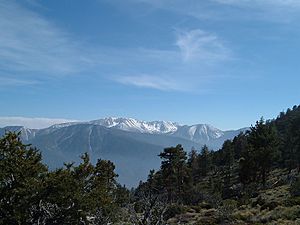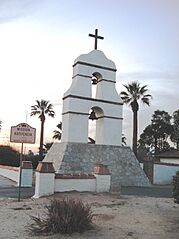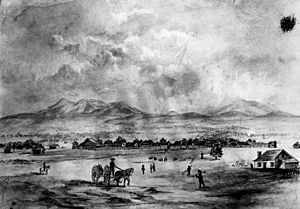Guachama Rancheria facts for kids
Quick facts for kids Guachama Rancheria |
|
|---|---|

San Bernardino mountains above Redlands
|
|
| Location | Loma Linda, California |
| Designated | March 29, 1933 |
| Reference no. | 95 |
| Lua error in Module:Location_map at line 420: attempt to index field 'wikibase' (a nil value). | |
Guachama was an important village of the Tongva people. It was located in what is now Redlands, California, in the San Bernardino Valley. The Tongva name for the village was Kaawchama, or Wa’aachnga, which meant "plenty to eat."
Later, the Spanish called it the Guachama Rancheria after they built a supply station there in 1810. This station helped Mission San Gabriel. After 1833, when the missions were no longer controlled by the church, the area became part of Rancho San Bernardino.
Contents
The Story of Guachama Rancheria
The Tongva Village of Kaawchama
Kaawchama was one of the easternmost villages of the Tongva people. Their land was called Tovaangar. The village was connected to a large trading network by the Mohave Trail. This trail stretched from villages in southern California all the way to the Colorado River.
In 1771, Spanish settlers built Mission San Gabriel. Kaawchama was about 50 miles east of the mission. The Spanish soon saw the village as a good place for an outpost. Missionaries had known about Kaawchama since the 1770s. But there was no European building there. This was a problem for them when they traveled the Mohave Trail. They needed a place to get supplies.
In 1810, about 1,000 Mohave warriors traveled through the village. They had planned to attack Mission San Gabriel. But they changed their minds. Instead, they captured 3,000 sheep.
On May 10, 1810, a priest named Francisco Dumetz from Mission San Gabriel came to Kaawchama. He set up the supply station that was needed. They found a perfect spot. The valley had lots of water and green plants. The Guachama people had a large village there. Other villages were also in the valley. Many of their names were later used by settlers for their ranches.
Guachama Becomes a Rancheria

After 1812, many of the Guachama people moved closer to Los Angeles. This allowed the Cahuilla and Serrano people to live in the settlement.
The area became known as Rancho San Bernardino. It was a center for farming and raising cattle. The Guachama people were taught how to farm and care for the animals. Water ditches, called zanjas, were built to bring water to more farmland. From this time, Guachama Rancheria was called San Bernardino. In 1819, it was officially named San Bernardino Rancho of the Mission San Gabriel.
Because of floods from San Timoteo Creek, the mission was moved to higher ground in 1830. Some old ruins still remain at the original site.
The Rancho San Bernardino Land Grant
In 1842, the Mexican Governor Juan B. Alvarado gave a large land grant. This grant was given to José del Carmen Lugo, José María Lugo, Vicente Lugo, and Diego Sepulveda. This created the Rancho San Bernardino. The land grant covered about 35,509 acres (144 square kilometers). Today, this area includes parts of the San Bernardino valley, San Bernardino, Fontana, Rialto, Redlands, and Colton.
Remembering Guachama Rancheria
In 1933, the Guachama Rancheria site was named a California Historic Landmark. It was given the number 95 on March 29, 1933. A special marker was placed at 25894 Mission Road, Loma Linda, California.
As mentioned, "Guachama" comes from the Tongva name meaning "a place where there is plenty to eat." This was because there were fresh springs and creeks in the area, which provided lots of food.
The marker at the site says:
- NO. 95 GUACHAMA RANCHERIA - Guachama Rancheria, renamed San Bernardino on May 20, 1810, by Francisco Dumetz, became the San Bernardino Rancho of the Mission San Gabriel in 1819. The adobe administration building stood 70 yards north of this spot, an enramada served as the chapel, and a zanja was constructed to bring water from the mountains for irrigation. Control by mission fathers ended in 1834." This marker was put up in 1932 by the Arrowhead Chapter Daughters of the American Revolution.


